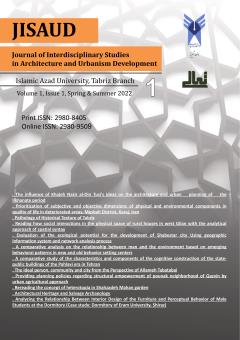A comparative study of the characteristics and components of the cognitive construction of the state-public buildings of the Pahlavi era in Tehrann
Subject Areas :
Yusef Goodarzi
1
,
Mehrdad Matin
2
*
,
Vahid Ghobadian
3
![]()
1 - Department of Architecture, Central Tehran branch, Islamic Azad University, Tehran, Iran.
2 - Department of Architecture, Central Tehran branch, Islamic Azad University, Tehran, Iran. (Corresponding Author) mehrdad.matin@ymail.com
3 - Department of Architecture, Central Tehran branch, Islamic Azad University, Tehran, Iran.
Keywords: Tehran, architecture, Indicators, Pahlavi, components of cognitive construction,
Abstract :
The purpose of this research is to compare the architectural features and structural components of government-public buildings of the first Pahlavi period and the second Pahlavi period in Tehran. Since in the present research the influencing factors and theories of contemporary architecture in Iran are studied and investigated, on the one hand, the research was theoretical and on the other hand, the results obtained from the above research can be used as a strategy to improve the current state of architecture. It is also a type of applied research. Also, the nature of the research is analytical-historical because it is devoted to the investigation of historical phenomena and the influence of contemporary architecture, and on the other hand, considering that the phenomena have a qualitative aspect, they were examined and analyzed. In this regard, the components of cognitive construction as subsets of Pahlavi era architectural features were scored and weighted with Topsis software. According to the points obtained, the national, archeological and western indicators with an average percentage of 39.9 were placed in the first place among the first Pahlavi indicators. Also, the component of the use of native and historical elements along with Islamic motifs, which is under the traditionalist index, has the first rank of the components of the cognitive construction of the first Pahlavi period, with a Ci value of 0.459. Also, the modern indicator with an average percentage of 41.35 was ranked first among the second Pahlavi indicators. The component of the use of Iranian-Islamic geometry, which is under the traditionalist index, has taken the first place among the components of the cognitive construction of the second Pahlavi period with a value of Ci 0.455.
_||_

